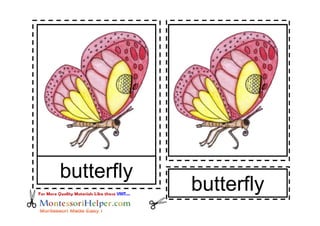Montessori butterfly nomenclature cards ages 6 to 9
- 2. This member of the Phylum Arthropoda, Class Insecta, Order Lepidoptera is a flying Insect with two pairs of delicate wings. It has three pairs of jointed wings and a proboscis through which it sips nectar. butterfly This member of the Phylum Arthropoda, Class Insecta, Order Lepidoptera is a flying Insect with two pairs of delicate wings. It has three pairs of jointed wings and a proboscis through which it sips nectar. butterfly
- 4. This is broken into three segments, each with a pair of jointed legs. Four wings are attached to two of the segments. On the second and third segments the spiracles are found and in many families the auditory organs are found on the third segment, or metathorax thorax This is broken into three segments, each with a pair of jointed legs. Four wings are attached to two of the segments. On the second and third segments the spiracles are found and in many families the auditory organs are found on the third segment, or metathorax thorax
- 6. These openings along part of the thorax and abdomen allow air to be pumped in and out of the trachea with help from movement of the winds and abdomen spiracles These openings along part of the thorax and abdomen allow air to be pumped in and out of the trachea with help from movement of the winds and abdomen spiracles
- 8. These are tiny overlapping shingles, which give the wings a distinctive color and pattern when light is reflected off them. scales These are tiny overlapping shingles, which give the wings a distinctive color and pattern when light is reflected off them. scales
- 9. body body
- 10. The butterfly has a head thorax and abdomen. These parts are usually brown or black in color. body The butterfly has a head thorax and abdomen. These parts are usually brown or black in color. body
- 11. head head
- 12. Two long antennae originate from here as well as a pair of ocelli, the mouth and sensory organs. head Two long antennae originate from here as well as a pair of ocelli, the mouth and sensory organs. head
- 13. eye eye
- 14. There is a large compound set of these organs of vision on each side of the head and some butterflies also have a second simple set above the compound set. eye There is a large compound set of these organs of vision on each side of the head and some butterflies also have a second simple set above the compound set. eye
- 15. wings wings
- 16. Butterflies have two pairs of these, which enable flight. They are thin, brightly colored and covered in scales. Their hollow ribbing, or veins provide support. When at rest these are folded in an upright position. wings Butterflies have two pairs of these, which enable flight. They are thin, brightly colored and covered in scales. Their hollow ribbing, or veins provide support. When at rest these are folded in an upright position. wings
- 17. abdomen abdomen
- 18. This is the segmented latter portion of the body containing genitalia and spiracles. abdomen This is the segmented latter portion of the body containing genitalia and spiracles. abdomen
- 19. legs legs
- 20. Butterflies have three pairs of these long jointed appendages. Some species have taste buds on the soles and distal ends. legs Butterflies have three pairs of these long jointed appendages. Some species have taste buds on the soles and distal ends. legs
- 21. mouth mouth
- 22. This long, coiled tube-like tongue is used to suck nectar. It has evolved from mouth parts that used to chew. mouth This long, coiled tube-like tongue is used to suck nectar. It has evolved from mouth parts that used to chew. mouth
- 24. This is comprised of two pairs of sensory palpi and a proboscis. proboscis This is comprised of two pairs of sensory palpi and a proboscis. proboscis
- 26. These are segmented smell and touch sensors with knobs at the ends. They can have from 7 ŌĆō 1000 segments. antennae These are segmented smell and touch sensors with knobs at the ends. They can have from 7 ŌĆō 1000 segments. antennae
- 28. These are tympanic hearing receptors located on the metathorax in some butterflies. sound receptors These are tympanic hearing receptors located on the metathorax in some butterflies. sound receptors




























